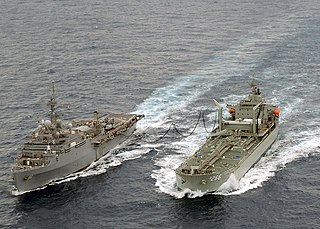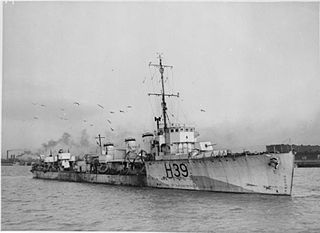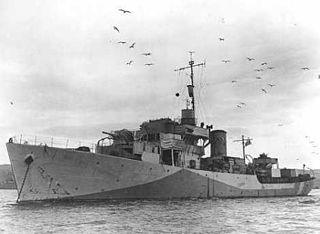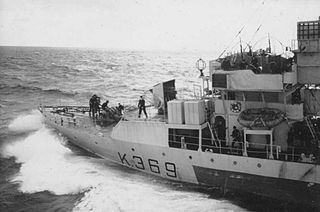
The Royal Navy (RN) is the naval warfare force of the United Kingdom, British Overseas Territories and Crown Dependencies, and a component of His Majesty's Naval Service. Although warships were used by English and Scottish kings from the early medieval period, the first major maritime engagements were fought in the Hundred Years' War against France. The modern Royal Navy traces its origins to the English Navy of the early 16th century; the oldest of the UK's armed services, it is consequently known as the Senior Service.

The Royal Canadian Navy is the naval force of Canada. The navy is one of three environmental commands within the Canadian Armed Forces. As of February 2024, the RCN operates 12 Halifax-class frigates, 12 Kingston-class coastal defence vessels, 4 Victoria-class submarines, 4 Harry DeWolf-class offshore patrol vessels, 8 Orca-class patrol vessels, and several auxiliary vessels. The RCN consists of 8,400 Regular Force and 4,100 Primary Reserve sailors, supported by 3,800 civilians. Vice-Admiral Angus Topshee is the commander of the Royal Canadian Navy and chief of the Naval Staff.

The Grand Fleet was the main battlefleet of the Royal Navy during the First World War. It was established in August 1914 and disbanded in April 1919. Its main base was Scapa Flow in the Orkney Islands.

The S and T class was a class of sixteen destroyers of the Royal Navy launched in 1942–1943. They were built as two flotillas, known as the 5th and 6th Emergency Flotilla, and they served as fleet and convoy escorts in World War II.

The River class was a class of 151 frigates launched between 1941 and 1944 for use as anti-submarine convoy escorts in the North Atlantic. The majority served with the Royal Navy and Royal Canadian Navy (RCN), with some serving in the other Allied navies: the Royal Australian Navy (RAN), the Free French Naval Forces, the Royal Netherlands Navy and, post-war, the South African Navy.

HMS Bramham (L51) was a Hunt-class destroyer of the Royal Navy laid down in Alexander Stephen and Sons shipyards Govan, Scotland on 7 April 1941. She was launched on 29 January 1942 and commissioned into the Royal Navy on 16 June 1942. She was named after the Bramham Moor Hunt and has been the only Royal Navy warship to bear the name. She was adopted by the town of Beverley in the East Riding of Yorkshire during the Warship Week savings campaign of 1942.

A replenishment oiler or replenishment tanker is a naval auxiliary ship with fuel tanks and dry cargo holds which can supply both fuel and dry stores during underway replenishment (UNREP) at sea. Many countries have used replenishment oilers.

The Laforey class was a class of 22 torpedo boat destroyers of the Royal Navy, twenty of which were built under the Naval Programme of 1912–13 and a further two under the 2nd War Emergency Programme of 1914. As such they were the penultimate pre-war British destroyer design. All served during World War I during which three were lost; the survivors were all scrapped in 1921-23.

The Bangor-class minesweepers were a class of warships operated by the Royal Navy (RN), Royal Canadian Navy (RCN), Imperial Japanese Navy (IJN), and Royal Indian Navy (RIN) during the Second World War.

A infantry landing ship was one of a number of types of British Commonwealth vessels used to transport landing craft and troops engaged in amphibious warfare during the Second World War. LSIs were operated by the Royal Navy, British Merchant Navy, Royal Canadian Navy, Royal Indian Navy, and Royal Australian Navy. They transported British Commonwealth and other Allied troops in sea assaults and invasions throughout the war.

The J, K and N class consisted of 24 destroyers built for the Royal Navy beginning in 1938. They were a return to a smaller vessel, with a heavier torpedo armament, after the Tribal class that emphasised guns over torpedoes. The ships were built in three flotillas or groups, each consisting of eight ships with names beginning with "J", "K" and "N". The flag superior of the pennant numbers changed from "F" to "G" in 1940.

The first R class were a class of 62 destroyers built between 1916 and 1917 for the Royal Navy. They were an improvement, specifically in the area of fuel economy, of the earlier Admiralty M-class destroyers. The most important difference was that the Admiralty R class had two shafts and geared turbines, compared with the three shafts and direct turbines of the Admiralty M class, but in appearance the R class could be distinguished from its predecessors by having the after 4-inch gun mounted in a bandstand. The Admiralty ordered the first two of this class of ships in May 1915. Another seventeen were ordered in July 1915, a further eight in December 1915, and a final twenty-three in March 1916.

Adrias was a Type III Hunt-class destroyer that was originally built for the Royal Navy as HMS Border but never commissioned. Before her completion, she was loaned to the Royal Hellenic Navy on 20 July 1942 and commissioned as Adrias on 5 August 1942 in order to relieve heavy losses of ships sustained by the Royal Hellenic Navy during the German invasion of 1941 and throughout the war. Adrias took her name from the ancient Greek town of Adria in Italy, at the mouth of the Po river, after which the Adriatic Sea is named.

The Medea class were a class of destroyers that were being built for the Greek Navy at the outbreak of World War I but were taken over and completed for the Royal Navy for wartime service. All were named after characters from Greek mythology as result of their Greek heritage.

HMCS Long Branch was a modified Flower-class corvette that served in the Royal Canadian Navy during the Second World War. She was used primarily as a convoy escort in the Battle of the Atlantic. She was laid down as HMS Candytuft but was transferred to the RCN on 5 January 1944 before completion. She was named for Long Branch, Ontario, a village that was eventually amalgamated into Toronto, Ontario.
HMS Deane was a Captain-class frigate, originally to be built for the U.S. Navy as a Buckley-class destroyer escort. Before she was finished in 1943, she was transferred to the Royal Navy under the terms of Lend-Lease, and saw service during World War II.

The Astraea class was an eight ship class of protected cruisers built for the Royal Navy during the 1890s. The ships served on a number of foreign stations during their careers, particularly in the waters of the Indian and Pacific Oceans, and around the Cape of Good Hope. Already obsolete by the outbreak of the First World War, most continued to see service in a variety of roles, though rarely in a front line capacity. By the end of the war the majority were being used as training or depot ships, and they were soon sold out of the service and scrapped. However, one ship, HMS Hermione, was bought by the Marine Society and used as a training ship until 1940.

HMCS West York was a Flower-class corvette of the Royal Canadian Navy which took part in convoy escort duties during the Second World War. Named after Weston, Ontario, she was built by Midland Shipyards Ltd. in Midland, Ontario and commissioned on 6 October 1944 at Collingwood.
HMS Oxlip was a Flower-class corvette that served in the Royal Navy during World War II.

















